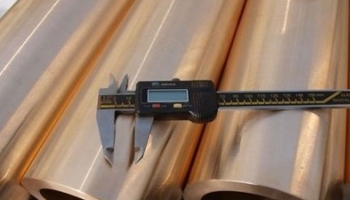The beryllium copper heating time encompasses both the heating and heat preservation (soaking) times. Short heating times, high heating rates, and uniform heating are needed to minimise ingot oxidation and energy consumption. It is essential to add up and take into account the heating temperature, the type of alloy, and the ingot’s dimensions in order to calculate the beryllium copper heating time.
The beryllium copper should be heated quickly and for the proper amount of time. Heat conduction is quick, the furnace temperature is high, and the temperature increases quickly. High-temperature heating has many advantages, especially for metals and alloys with excellent thermal conductivity. For some metals, however, the ingot will merely result in the overburn of coarse grains. The primary purpose of the soaking procedure is to prevent an excessive temperature difference between the ingot’s various components. Generally speaking, the temperature differential cannot be greater than 15-20 degrees Celsius; consequently, the better the ingot’s temperature uniformity, the better. Uneven heating will result in issues like cracks, waves, sickle curves, uneven thickness, and challenging biting when hot rolling. When the ingot size is big, the beryllium copper heating time should be appropriately prolonged, or the heating furnace temperature should be appropriately raised.
The beryllium copper heating components are more intricate. Therefore, during the actual production process, we must always remember the beryllium copper heating principle, accurately and flexibly apply the beryllium copper heating techniques, and constantly enhance the beryllium copper processing quality and power.
On the ageing characteristic curve, the relative maximum strength value will be visible when ageing at a temperature greater than 340 degrees Celsius. If the quantity of cold working remains constant, the strength corresponding to this maximum strength will diminish as the ageing temperature rises. If the ageing temperature is set and the rate of cold deformation is increased, the relative maximum strength value will slightly increase and the time of presentation will also be shortened. This results in a shorter ageing time to achieve the corresponding strength value. The ageing hardening of beryllium bronze only creates a meta-stable sedimentary phase below 330 degrees Celsius; above 330 degrees Celsius, it can create an equilibrium sedimentary phase or a meta-stable phase, with the latter being centred on the grain boundaries.
To prevent under and over-ageing, the temperature of beryllium copper during the ageing process needs to be carefully regulated. Under-ageing can also be made up for by ageing to achieve the necessary mechanical function, but once over-ageing begins, it is difficult to reverse without repeated solution heat treatment. Of course, the necessary functions can also be achieved by maximising the interaction between cold work, underaging, and averaging. For instance, when the strength is less than the maximum value asked, cold work and under- or over-ageing (lowering temperature, extending the time, or increasing temperature, shortening the time) are used to achieve the mechanical function of beryllium bronze that is desired.
Read More :
The Casting Shortening Rate Of Beryllium Copper Rod Is Small: Beryllium copper rods are used in the atmosphere, in seawater, in freshwater, and in steam for steam boilers and maritime ship components. Copper beryllium which contains phosphorus has mechanical properties and can be used in high-precision machine tools as polishing and elastic components.
C17200 Can Be Used As High Air Tightness Casting: It has been used for approximately 6,000 years. C17200 has excellent mechanical and technological properties, and it can be welded and brazed without sparks during impact.

